Sparta Praha had not won the Czech First League for almost a decade.
That was until last season when Brian Priske took charge of the team and led them back to the very top of Czech football.
This year, they’ve made another step while leading the league over rivals Slavia Praha, qualifying for the UEFA Europa League knockout stage from a tricky group containing Real Betis, Rangers and Aris Limassol.
When watching Sparta Praha’s games, their pressing must be the most impressive part of their performance.
They are a very disciplined team that controls the opponent out of possession.
This Sparta Praha tactical analysis details how the current Czech champions set up their press, how they use it to create chances, and how teams have dealt with it in the UEFA Europa League.
Sparta Praha Zonal Man-man Press
Sparta have utilised a 3-4-3 formation under Brian Priske’s coaching style.
One reason might be that the Danish coach has always found this a good way to press the opponents with a clear division of responsibilities on the pitch.
It allows them to use a zonal man-man scheme, locking each individual down and preventing the opponent from easily finding a free player in the build-up.
At the same time, the last line would be more organised to defend zonally rather than following their man all the way.
Sparta Praha Defensive Territory Map
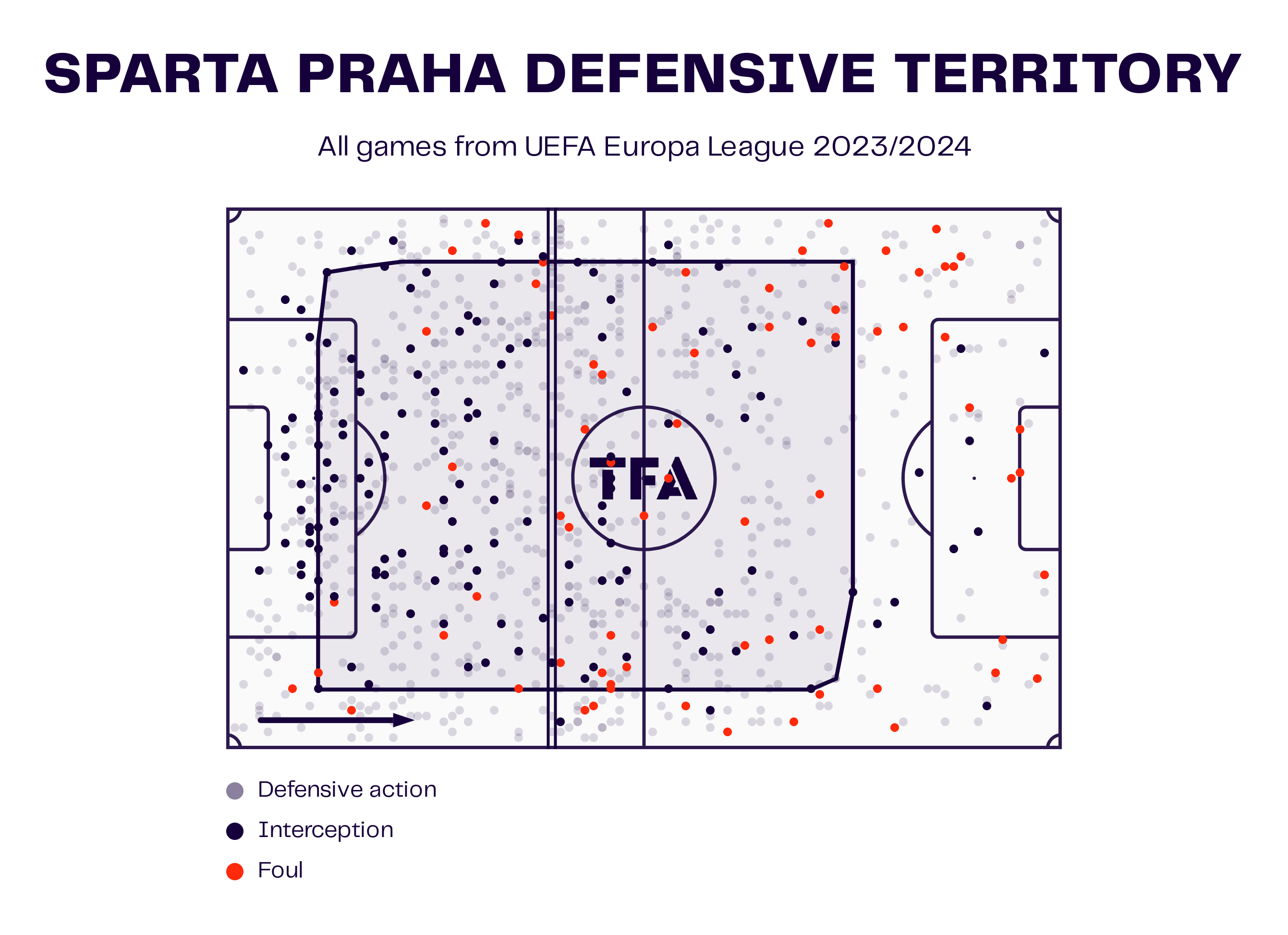
There are interesting observations in the Sparta Praha defensive territory graph.
They usually intercept the ball in the half-spaces or wide spaces in the opposition half, and not many of these events occurred centrally.
Then, there’s an even clearer trend if we look at the locations of fouls.
They were also scattered on the sides, and barely any red dots were in the centre.
Sparta Praha's defensive actions are almost empty in front of the opposition penalty box, but the grey dots are condensed nearer the sidelines.
Sparta Praha Pressing Shape
Here, we’ll use some game examples to explain how Sparta Praha shaped their press; they have mainly been able to control most opponents, including Liverpool.
Although the Reds beat them 11-2 over two legs, many of the goals conceded were attributed to Sparta Praha’s build-up mistakes rather than the press being outplayed.
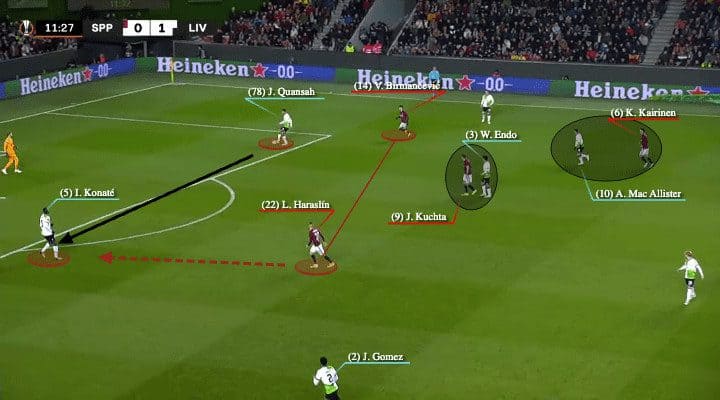
In a 3-4-3 formation, the front three were rarely on the same line; it would be more of a 1-2 shape, but the shape is not as important as who the mark is.
The shape was merely an outcome of the striker, Jan Kuchta, marking the opposition midfielder (Wataru Endo), while the wingers – Veljko Birmančević and Lukáš Haraslín were going for their centre-backs in a back four.
Then, the other two Sparta Praha midfielders should also lock the Liverpool midfielders to match it a man-man in midfield, as shown here where we see Kaan Kairinen marking Alexis Mac Allister, leaving the opposition full-backs initially unmarked as bait.
Then, it was about angling the press and seeing the pressing trigger.
If Jarrell Quansah passes to his partner, Ibrahima Konaté, Haraslín should jump on the receiver quickly.
Sparta Praha Pressing Trigger
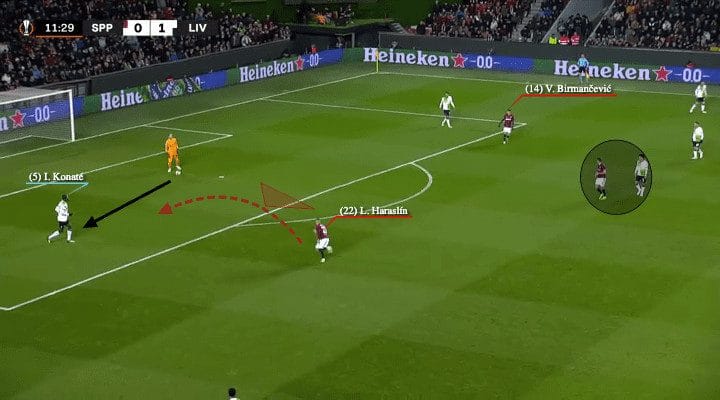
But it wasn’t the case, as Quansah gave the ball to the ‘keeper instead of his partner.
Then the press of Haraslín has to be different if he wants to press Konaté — the Slovakian winger should curve his run a little bit to cover the centre more and push Liverpool to one side (at the expense of giving up some speed to access his mark.)
Sparta Praha Pressing Trap
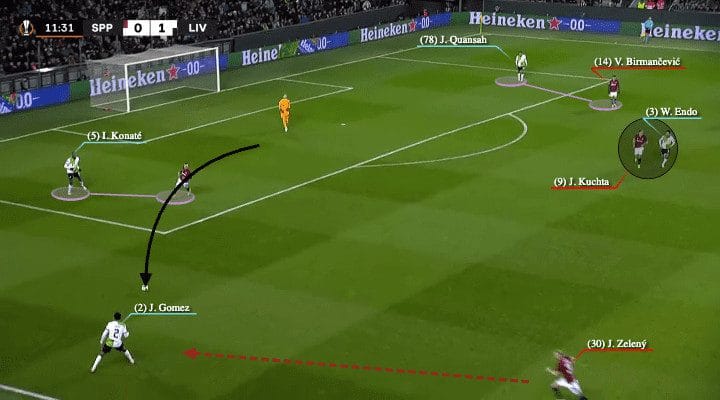
Liverpool, of course, were clever to anticipate the nearest potential danger.
Hence, the ‘keeper avoided the pass to Konaté, as he thought Joe Gomez would be a better option out wide without a marker near him at first.
However, this was a pressing trap!
The chipped ball was more difficult to control and required more time to travel to the receiver, so it became another clear pressing trigger for Jaroslav Zelený to jump on his mark — wing-back on full-back.
Then, Liverpool could not keep the ball and conceded a throw-in.
Below is another example of Sparta Praha pressing, this time, their league opponent FC Zlín.
Sparta Praha Pressing Trigger Against A Back-three
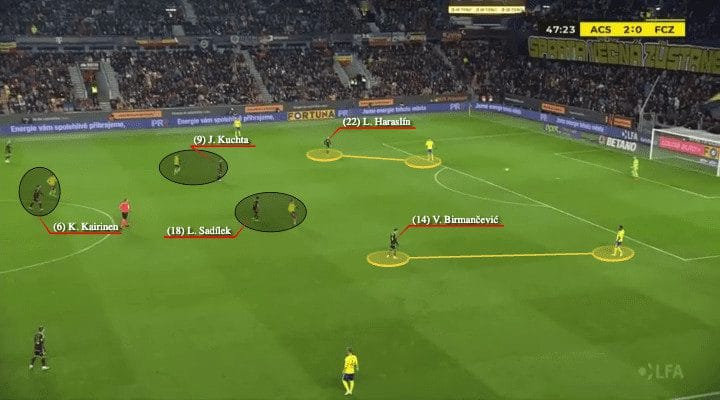
The latter played in a back three but pushed the central centre-back higher in the build-up phase.
Jan Kuchta’s mark changed from marking the midfielder to tracking this centre-back so that they kept a 3v3 and allowed the midfielders (Kairinen and Lukáš Sadílek) to mark the opposition midfielders.
Then, the wingers easily identified the wide centre-backs as their mark.
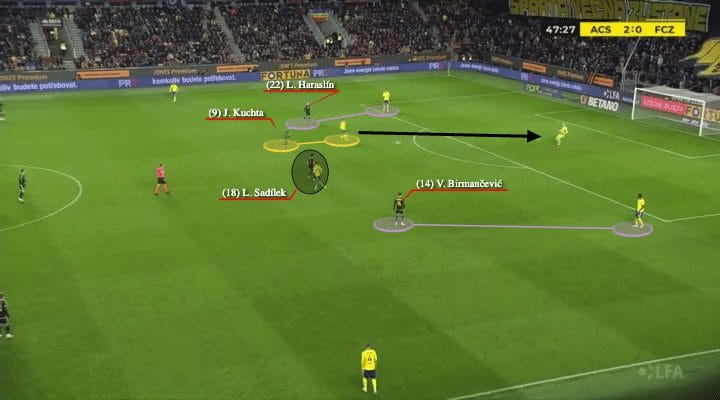
Sparta’s wingers led the press in the example versus Liverpool, but this time was different, as the striker could take that role.
When Kuchta’s mark played a back pass to the keeper, it was clear that he should chase the pass down and put pressure on the goalkeeper from the centre instead of a winger showing direction from the side.
They were very disciplined in the press—except for Jan Kuchta, who jumped on the goalkeeper.
The rest stayed on their marks.
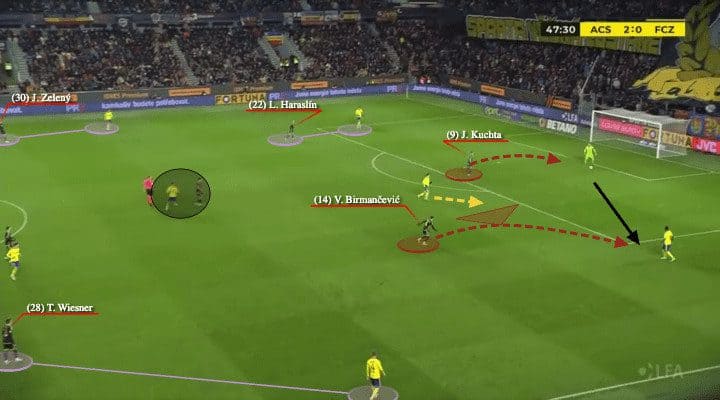
Again, the press on the goalkeeper was not only straight but intent on guiding the play direction to one side by curving the runs.
Kuchta did that when going out.
Then, the question was, how can we keep the player who made the back pass under control?
This was how the zonal man-man worked.
To compensate, Birmančević had to stay inside a bit longer to control that space and ensure he could run towards that mark if the keeper played central while leaving the wide centre-back as bait.
Then, the ‘keeper was tempted to play wider so Veljko Birmančević could curve his run to push the play outside.
Now, FC Zlín were in the pressing trap.
Sparta Praha Pressing Trap Against A Back-three
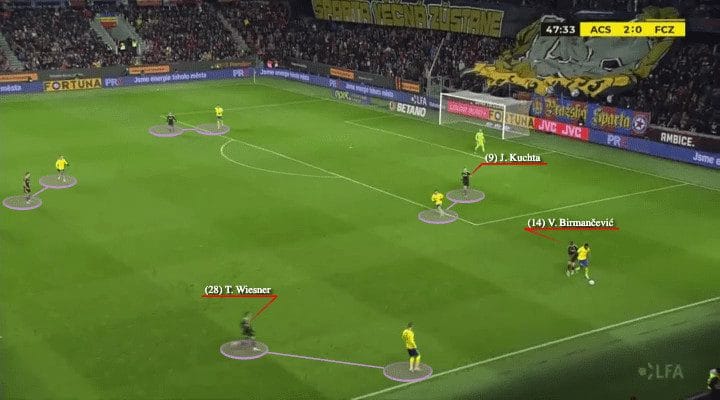
Birmančević went towards the receiver with speed, who was trapped on the side, while Jan Kuchta ran back to take his mark; there was no option on the same side as well, as Tomáš Wiesner was going tight on the opposition wing-back.
And look at the broader picture — see how disciplined the press was — the Sparta Praha far-side winger and midfielder stayed on their mark instead of chasing the ball.
Despite pressing on a zonal man-man basis, Sparta Praha’s front three’s defensive roles were also similar to prime Liverpool with Sadio Mané, Mohammed Salah, and Roberto Firmino.
The Brazilian striker usually marks the opposition midfielders and allows his wingers to shape their runs towards the ball holder.
It was a decent tactic when the players had the legs and intensity to make the effort.
Sparta Praha Chance Creation Through Press
The best part of this press was not only its usefulness in trapping opposition on one side
Priske’s side could also use it to create goalscoring chances because their wingers were usually disciplined and good at closing the passing lanes.
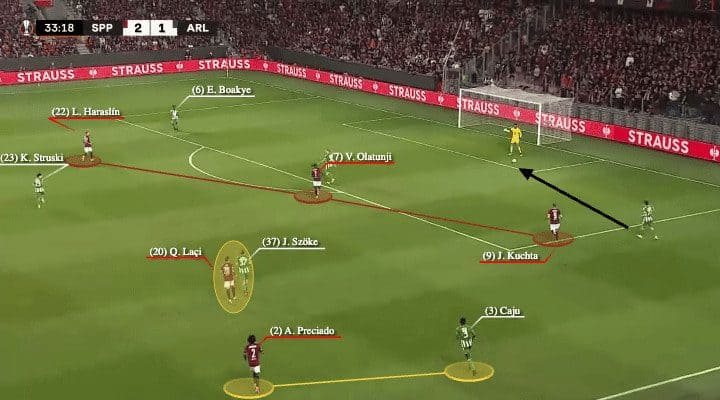
We took the situation of Sparta Praha-Aris Limassol to illustrate.
The zonal man-man was clear: Sparta Praha had a front three marking their respective mark, Kuchta inclining to the right side this time, plus midfielder Qazim Laçi (midfielder) on the opposition midfielder.
Then Angelo Preciado (RWB) was on the Aris Limassol wide defender, so the opponent went back to the ‘keeper.
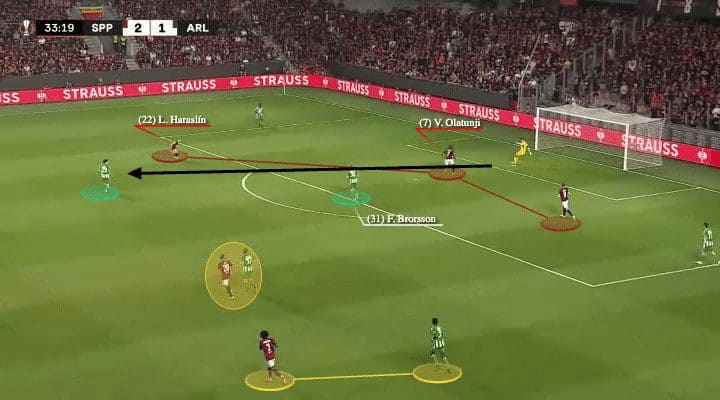
When the ball returned to the ‘keeper, Victor Olatunji left his mark (Franz Brorsson) and jumped centrally to force the opposition to play.
And look at Haraslín’s defensive position.
Although he was marking the centre-back, he did not completely get tight; he stayed more between the Aris Limassol midfielder and his mark.
This was crucial because it allowed him to intercept the pass if the ‘keeper went central while keeping the possibility to run towards the mark with speed if the central defender received.
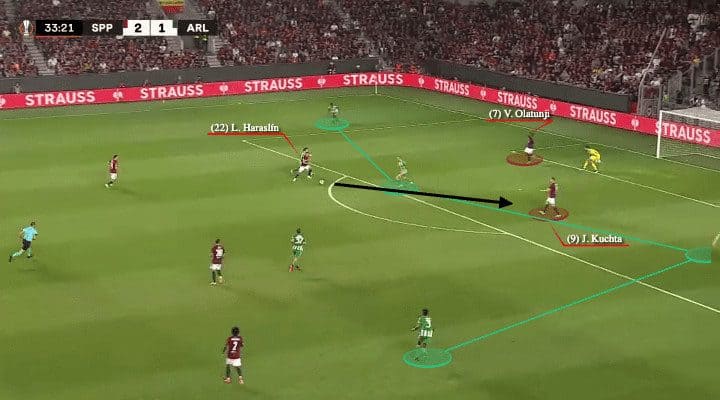
Because of Haraslín’s good defensive position, Sparta Praha intercepted the ball high and also looked at the condition to counterattack.
They regained in front of the opposition penalty box, with two players ahead as the passing options to finish.
Olatunji was clearly offside in this case, but the other attacker, Kutcha, was in a good central position and ready to finish.
Sparta Praha Pressing Weaknesses
Despite mentioning Sparta Praha’s good pressing principles and how they used it to create chances, we must remember that footballers are not robots.
The current Czech Champions have problems that opponents can exploit.
Galatasaray solved the defence by playing out from the back a few times in their matches.
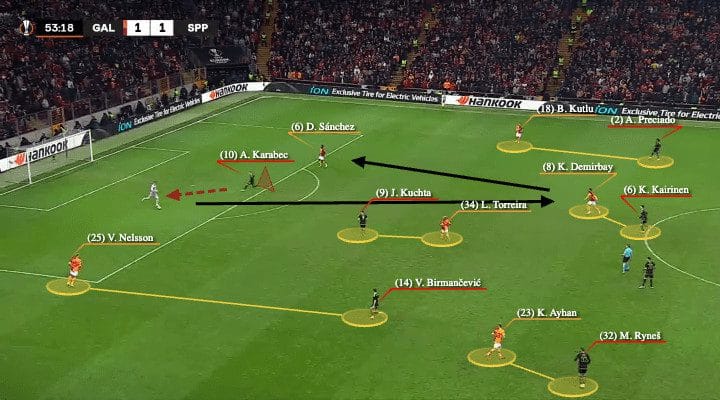
Sparta Praha is setting up a similar zonal man-man press in Turkey, with the right-winger Adam Karabec pressing the goalkeeper from one side to shape the play angle.
However, as Karabec left his mark, Davinson Sánchez became the free player to receive.
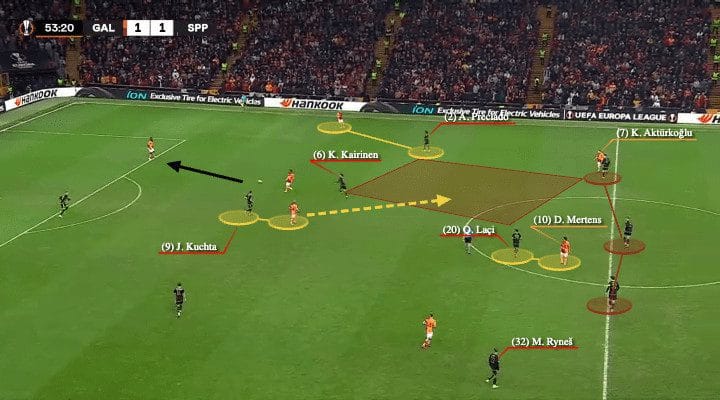
Sparta Praha could not block the central pass as Kerem Demirbay was receiving in front of his marker, and this was a good pass from Fernando Muslera.
As we explained above, Demirbay could control in front of Kairinen, so he identified the Colombian centre-back as a free option to receive.
Then, Sparta Praha was also exposed centrally as they did not protect the space if the opposition’s movement took out the midfielders.
There was ample space in there and a significant distance between Kairinen and Laçi.
Karabec was too far away to run back and close down Sánchez.
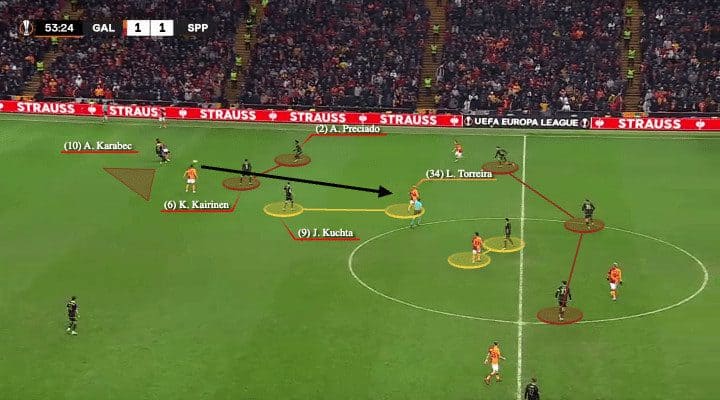
The problem was that Kutcha had lost the mark and got caught ball-watching in the sequence, so Torreira became totally free to receive without a Sparta Praha player next to him.
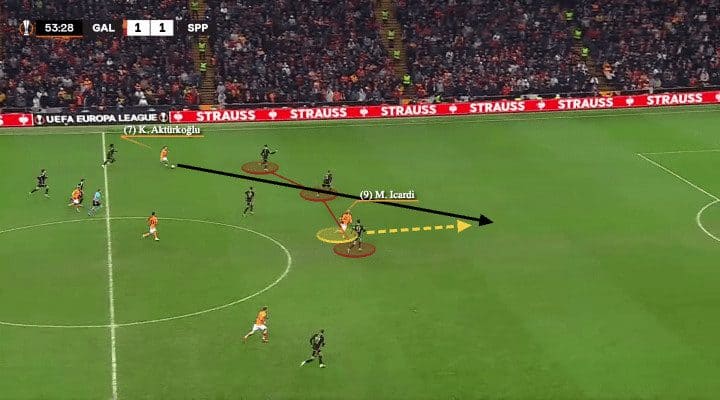
Good European teams could change the speed of their attack and build on that when they broke the first wave of pressure.
Here, we saw Mauro Icardi react quickly and check back from an offside position to make another run to exploit Sparta Praha’s last line, resulting in a 1v1 chance against the goalkeeper.
Conclusion
This Sparta Praha tactical analysis explains that the current Czech National champions are a very good pressing team under Brian Priske´s tactics.
They turned the tie around against Galatasaray from a 2-3 deficit in the first leg by winning 4-1 on their home soil. They also beat Real Betis in the UEFA Europa League group stage—all with the help of an intelligent, effective press.
It would be interesting to see if they can carry on to win the league title again this season, cementing Priske’s era in charge as one of sustained success.

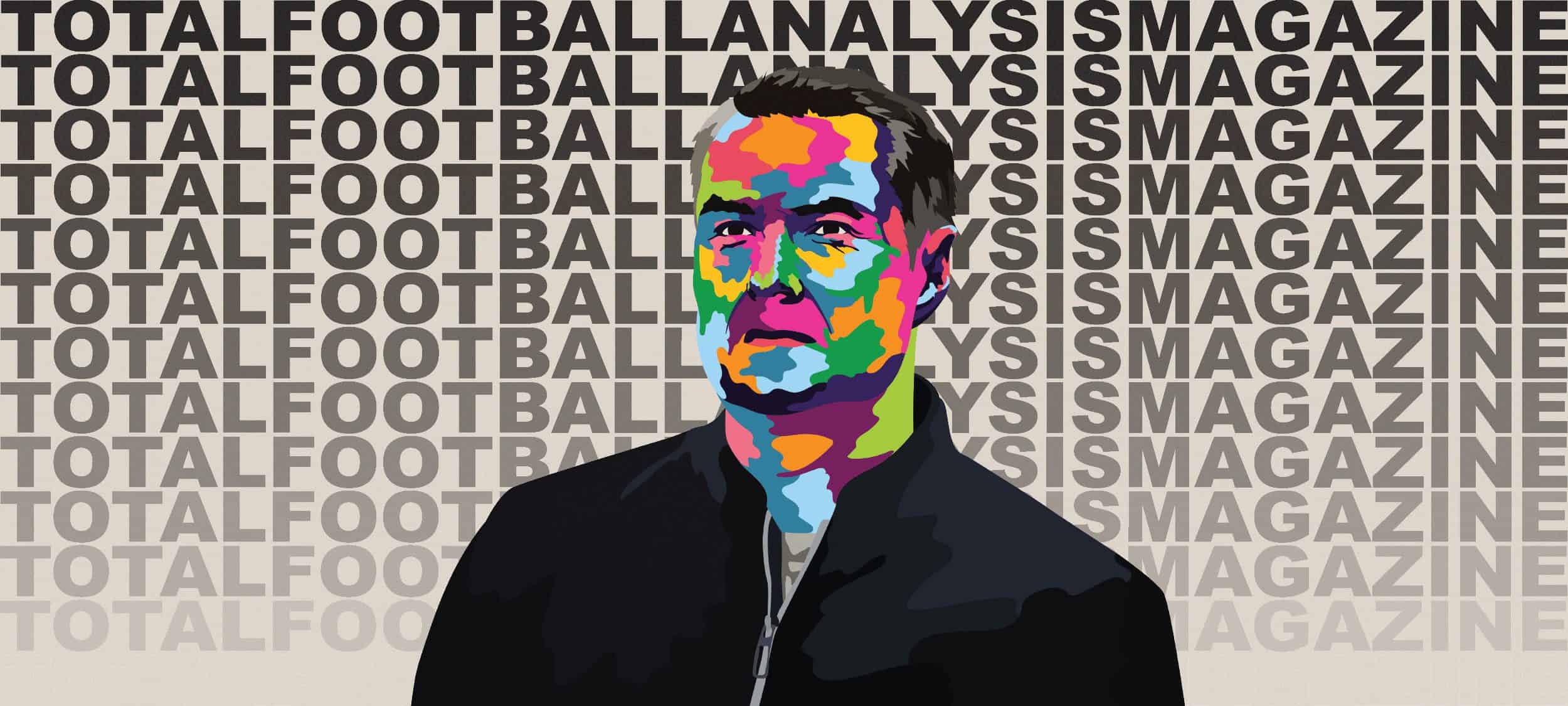



Comments